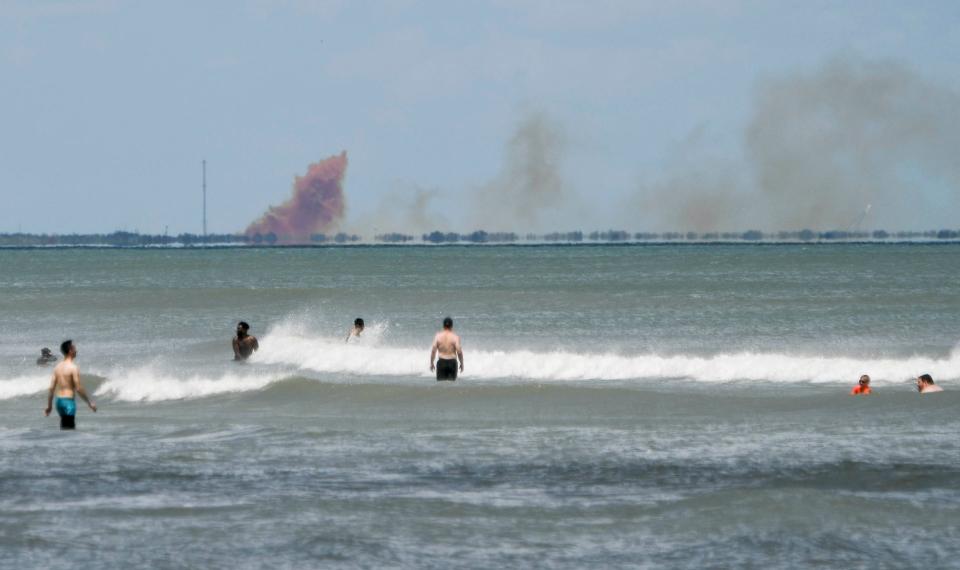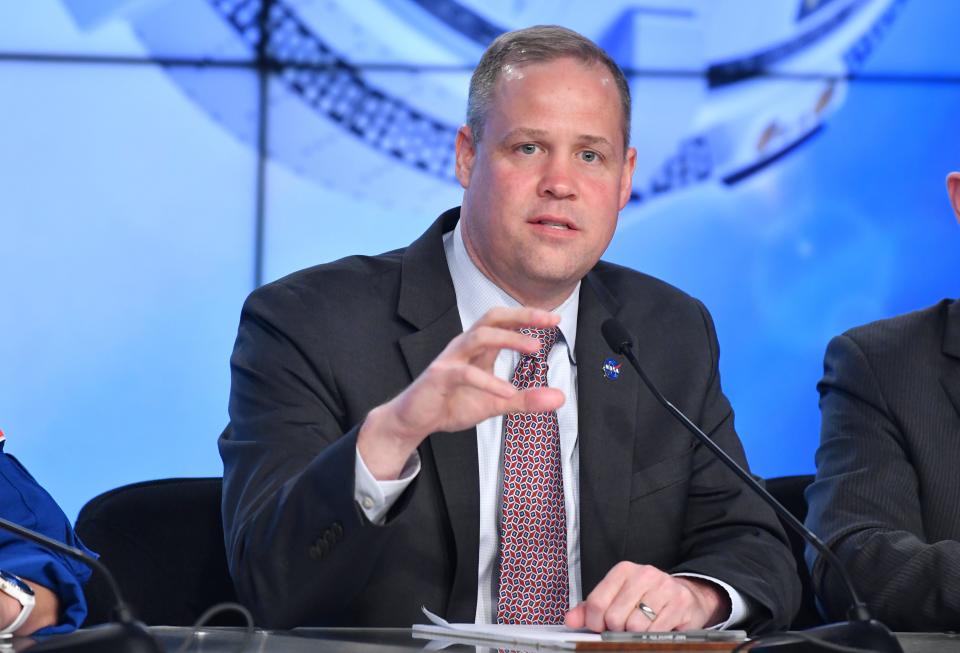SpaceX, Boeing compete to launch astronauts to International Space Station
SpaceX is on the final lap of the Commercial Crew race to space. If its in-flight abort test goes well Saturday, it could beat out Boeing to be the first private company to launch astronauts to the International Space Station.
“This has been a race from the very beginning. Boeing and SpaceX have been very competitive,” said Andy Aldrin, director of the Aldrin Space Institute at Florida Tech. “I don’t doubt that the program managers and their respective company are keeping a close eye on what the other guys are doing and want to get there first.”
The Commercial Crew space race began in September 2014 when NASA selected two private companies, SpaceX and Boeing, to build vessels to return American astronauts to space after the retiring of the shuttle in 2011. The United States has relied on the Russian Soyuz rocket to give astronauts a lift since then.
The goal was to have Americans flying to the space station on American vehicles by 2017.
“We’re looking to a future where we can be a customer, one customer of many customers, in a very robust commercial marketplace in low Earth orbit," NASA Administrator Jim Bridenstine said, “and having multiple providers competing on cost and innovation.”
Nominate, commemorate, celebrate: USA TODAY seeks your Women of the Century to honor 19th Amendment
A donut for a bun: Dunkin', Snoop Dogg collaborate on plant-based breakfast sandwich
At its core, the goal of the Commercial Crew program is for NASA to move away from owning, operating and maintaining spacecraft and instead to buy seats on capsules built by private companies.
Because SpaceX already had a cargo version of its Dragon capsule that docked with the ISS multiple times, it was ahead right out of the gate. In May 2015, SpaceX completed a successful "pad abort test" that simulated how Dragon would carry the astronauts to safety if an emergency occurred during launch.
It took nearly four years for SpaceX to complete the next major test, known as Demo-1, in which an unmanned Dragon docked with the ISS. In between those tests, the company was busy with its core business of cargo resupply missions to the ISS and mock landings and parachute testing.
“SpaceX came into it as a clear favorite. They already had the vehicle, so in theory, they were just going to need to put in the systems that were needed,” Aldrin said, “but as it turns out, that’s a lot more challenging than just putting in life support systems. Getting a vehicle ready to fly NASA astronauts involves a lot of work.”
In the predawn hours of March 2, 2019, SpaceX’s Falcon 9 rocket lifted off from pad 39A at Kennedy Space Center, carrying an anthropomorphic test dummy named Ripley headed for the space station. It was the first commercially built and operated American crew spacecraft and rocket to launch from U.S. soil on a mission to the ISS.
The roar of celebration at SpaceX headquarters in Hawthorne, California, was almost as deafening as the capsule’s powerful Merlin engines. A couple of days later, Dragon docked autonomously with the ISS – the first U.S. spacecraft to do so – and six days later, it returned to Earth, splashing down in the Atlantic Ocean.
It was such a historic achievement NASA won a prime-time Emmy for its coverage of the launch.
Nobody was cheering when a month later, the same capsule blew up during a routine abort system test at Cape Canaveral Air Force Station. It was a devastating set-back.

While NASA and SpaceX investigated the incident, SpaceX made modifications to the Dragon capsule while upgrading its parachute system.
Boeing was quietly making progress on its Starliner capsule. The company decided to land the capsule on the ground rather than in the ocean – a first for a U.S. crew capsule.
The pressure to keep up with SpaceX took its toll on employees.
“It feels like we’re failing. There are many days that I feel like I’m failing because of the schedule delays. It’s hard for us," Boeing design engineer Melanie Weber told Florida Today in September.
Weber said the comments of naysayers motivated the team to push harder.
“I feel like we’re the underdog. There’s a lot of negativity toward us and a lot of people saying that we’re not going to do it and we’re so far behind and it’s just not achievable,” Weber said.
In September, the Russian rocket that ensured America had a presence on the ISS for the past eight years was retired. SpaceX and Boeing were supposed to be making regular trips to the space station by then. With no American replacement ready, NASA was forced to buy more seats on the next version of Soyuz being built.
“Commercial Crew is years behind schedule,” Bridenstine tweeted, “It’s time to deliver.”
Letting go of the reins hasn’t been easy for NASA.
“The most culturally important, the most sacred thing that NASA does is fly astronauts, so giving up control of flying astronauts to a private company is a really big deal," said Jim Muncy, a space industry consultant. “Let’s just say that NASA hasn’t totally embraced the idea of giving up control."
In November, nearly six years after being selected, Boeing’s Starliner was ready for its big debut. The spacecraft tested its launch abort system at White Sands Missile Range in the New Mexico desert.
Though the test was considered a success, one of the three capsule parachutes didn't deploy.
SpaceX and Boeing have been plagued with parachute problems throughout development and testing.
Boeing didn’t let the parachute issue slow down its momentum. About a month later, engineers prepared for Starliner’s orbital flight test, the biggest milestone of their program.
The orbital flight test hoped to prove the spacecraft’s ability to launch to space, maintain orbit, dock with the ISS and safely return to Earth.
Shortly after launch, a problem with Starliner's "clock" prevented it from firing its boosters at the right time to put it into the proper orbit to reach the space station.
Engineers scrambled to find a solution, but when it became clear they couldn’t save the mission, they focused on getting Starliner back to Earth safely.
Two days later, Starliner landed in the New Mexico desert. Even though the spacecraft didn't dock with the ISS, the test proved several of the capsule's capabilities and was deemed a “successful failure.”
NASA hasn’t decided whether it will require Boeing to repeat the test before crewed flight.
“What you really don’t want to be is so far behind that you lose market share. But what you really, really don’t want to do is push so hard that you fail in a such a way that the customer, the astronauts, lose confidence in your program,” Aldrin said.
After Boeing’s orbital flight test, Bridenstine made the point that these setbacks are why NASA chose two companies in the first place.

“It is important for us as nation to maintain dissimilar redundancy, so when you look at the Boeing solution and the SpaceX solution, they are not the same, which means that when we do have a challenge that might set us back, the other one can keep going forward without putting us in a position where we might not have crew on the International Space Station,” Bridenstine said.
It’s SpaceX’s turn to move forward. Saturday, the company will test the Dragon’s ability to abort while in flight. This is the last test milestone before crewed flight, which means if it is successful, the historic return of astronauts launching from Kennedy Space Center may be only months away.
Launch Saturday
Rocket: SpaceX Falcon 9
Mission: Crew Dragon in-flight abort test
Liftoff: No earlier than 11 a.m. Saturday
Launch Complex: pad 39A at Kennedy Space Center
Contact Rachael Joy at 321-242-3577 and rjoy@floridatoday.com. Follow her on Twitter @Rachael_Joy.
This article originally appeared on Florida Today: SpaceX, Boeing race to send astronauts to International Space Station

